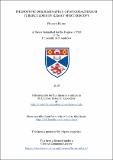Files in this item
Phenotypic discrimination of Mycobacterium tuberculosis by Raman spectroscopy
Item metadata
| dc.contributor.advisor | Gillespie, S. H. | |
| dc.contributor.author | Baron, Vincent | |
| dc.coverage.spatial | 294, [32] p. | en_US |
| dc.date.accessioned | 2018-11-27T17:21:43Z | |
| dc.date.available | 2018-11-27T17:21:43Z | |
| dc.date.issued | 2018-06-29 | |
| dc.identifier.uri | https://hdl.handle.net/10023/16562 | |
| dc.description.abstract | TB remains a major health issue worldwide causing around 1.5 deaths each year. The recent phase III clinical trials of shortened TB treatment failed to show superiority compared to the current regimen and this mainly because of relapse. Relapse is thought to be caused by dormant bacteria. Dormancy in Mycobacterium species has been shown to be associated with the accumulation of intracellular lipids, defining two phenotypes: the lipid rich (LR) cells (associated with dormancy) and the lipid poor (LP) cells (non-dormant). LR cells were shown to have a higher phenotypic antibiotic resistance compared to LP cells. Studying these two phenotypes is therefore central in tuberculosis research to understand better the disease and also potentially start to reveal the bacteriology of relapse. We investigated the power of Raman spectroscopy, a label-free and non-destructive technique, to discriminate LR and LP bacteria both in-vitro and ex-vivo. This represents the first Raman spectroscopy study that tries to discriminate the phenotypes of M. tuberculosis and investigate them directly at the site of the disease. Using total lipid extract of M. tuberculosis, we showed the location of the main lipid bands in the Raman spectrum. The two major lipid peaks were located around 1300 cm⁻¹ and 1450 cm⁻¹. Raman spectroscopy can discriminate LR and LP cells with high sensitivity and specificity. The main differences between the two groups are located in the two major Raman lipid peaks, the lipid band A (1300 cm⁻¹) and lipid band B (1440 to 1450 cm⁻¹). The two phenotypes were successfully discriminated in TB infected guinea pig lung tissue sections also from in-vitro culture using wavelength modulated Raman (WMR) spectroscopy combined with fluorescence imaging. We developed a protocol to perform both Raman spectroscopy and immunohistochemistry on the same tissue sample. We studied the evolution of LR and LP proportion in mycobacterial population as the growth conditions changed and showed that LR cells could rapidly convert to LP cells as they face favourable growth conditions. The results presented in this thesis showed that LR M. tuberculosis cells could be predominant at the site of infection. This would suggest that drug sensitivity testing should be performed on culture presenting both LR and LP cells in high proportion. | en_US |
| dc.description.sponsorship | "This work was supported by the PreDiCT-TB consortium [IMI Joint undertaking grant agreement number 115337, resources of which are composed of financial contribution from the European Union’s Seventh Framework Programme (FP7/2007– 2013) and EFPIA companies’ in kind contribution (www.imi.europa.eu)]." -- Acknowledgements | en |
| dc.language.iso | en | en_US |
| dc.publisher | University of St Andrews | |
| dc.rights | Attribution-NonCommercial-NoDerivatives 4.0 International | * |
| dc.rights.uri | http://creativecommons.org/licenses/by-nc-nd/4.0/ | * |
| dc.subject | Mycobacterium tuberculosis | en_US |
| dc.subject | Mycobacteria | en_US |
| dc.subject | Phenotypic antibiotic resistance | en_US |
| dc.subject | Raman spectroscopy | en_US |
| dc.subject.lcc | RA644.T7B2 | |
| dc.subject.lcsh | Tuberculosis | en |
| dc.subject.lcsh | Tuberculosis--Prevention | en |
| dc.title | Phenotypic discrimination of Mycobacterium tuberculosis by Raman spectroscopy | en_US |
| dc.type | Thesis | en_US |
| dc.contributor.sponsor | PreDiCT-TB Consortium | en_US |
| dc.contributor.sponsor | Innovative Medicines Initiative (IMI) | en_US |
| dc.contributor.sponsor | Seventh Framework Programme (European Commission) | en_US |
| dc.contributor.sponsor | European Federation of Pharmaceutical Industries and Associations (EFPIA) | en_US |
| dc.type.qualificationlevel | Doctoral | en_US |
| dc.type.qualificationname | PhD Doctor of Philosophy | en_US |
| dc.publisher.institution | The University of St Andrews | en_US |
| dc.publisher.department | School of Medicine | en_US |
The following licence files are associated with this item:
This item appears in the following Collection(s)
Except where otherwise noted within the work, this item's licence for re-use is described as Attribution-NonCommercial-NoDerivatives 4.0 International
Items in the St Andrews Research Repository are protected by copyright, with all rights reserved, unless otherwise indicated.


